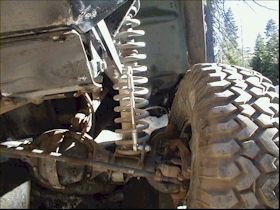|
|
|
Conclusions
 There
are two ways you can set the Anti-Rock's firmness. You can find a setting
that works for both street and trail, and never adjust it; the obvious
sacrifice being less axle droop off-road and more body-roll on-road.
Or, you can change the setting whenever you go from road to dirt or
vice versa.
There
are two ways you can set the Anti-Rock's firmness. You can find a setting
that works for both street and trail, and never adjust it; the obvious
sacrifice being less axle droop off-road and more body-roll on-road.
Or, you can change the setting whenever you go from road to dirt or
vice versa.
I want the stiffest setting on-road and the loosest off-road, so I break out the wrenches when I hit the trail and upon return, change the setting back. The setting is changed by disconnecting the end links from the end arms and moving the end link connection inward or outward, then reconnecting. Unfortunately this involves two box end wrenches and takes much longer than disconnecting a swaybar. It really is not fun. I would like to see Currie change the "ball" component of the heims on the end links to have a hex head on the outer part, so a ratchet & socket could be used rather than a box end wrench to change the setting.
In order to compare the flexiness of the TJ with the Anti-Rock on different settings, and disconnected altogether, I "ramped" the Jeep with a forklift. Using the standard formula of
RTI Score = ( (Tire Height)/(sin (Ramp Angle) ) / (Wheelbase Length) * 1000
Here are the results I came up with:
|
Tire
Height
|
|||
| Disconnected 33.25" height |
Loosest
Setting 32.00" height |
Firmest
Setting 31.25" height |
|
| 20° Ramp | 1050 | 1011 | 987 |
| 23° Ramp | 920 | 885 | 865 |
| 30° Ramp | 719 | 692 | 676 |
As you can see, the tire height did not vary much between having the Anti-Rock on different settings, and disconnected altogether. The largest difference was only 2". It seems on a standardized test that the loss of travel is minimal, and probably not of much consequence in your actual wheeling.
The Currie Anti-Rock is advertised as providing balanced performance and increased traction. These claims are both true, though if you have been driving with a disconnected sway bar for a while, using the Anti-Rock takes some getting used to on-road and off. You'll have to learn how it changes the way your vehicle responds to dips and hills in the terrain, and you'll have to learn how to take corners a little easier on the street.
As it turns out, none of these changes is hard to get used to, although the effect they have on the actual driving of the vehicle, to me, was minimal. I did not feel a vast improvement in traction, though I could feel the Anti-Rock changing the balance of the Jeep, which affected the traction. I can't say that it "aided" my driving really, just changed the way I reacted to the Jeep's movements. Once I got used to this, I really felt no difference…and perhaps that was the point. The Anti-Rock could be doing its job and it didn't even phase me.
Intro | Installation | On-Road | Off-Road | Conclusions
.|
Help spread the ROCKCRAWLER world!
|
